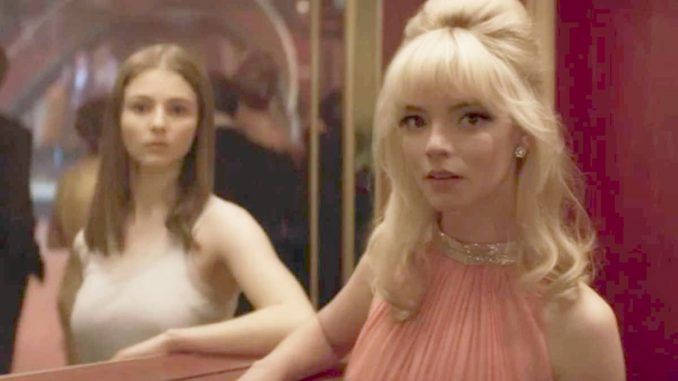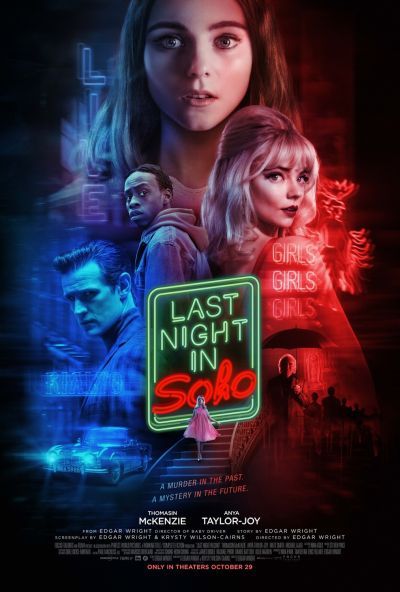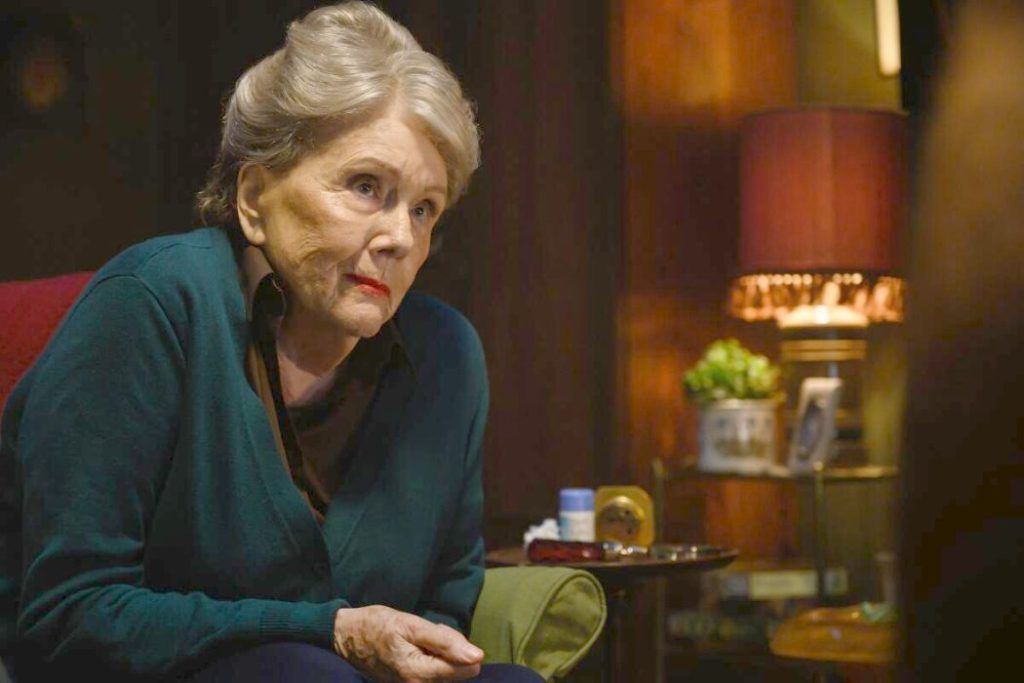
Rating: D+
Dir: Edgar Wright
Star: Thomasin McKenzie, Anya Taylor-Joy, Matt Smith, Diana Rigg
Well, this is a bit of a mess. Introverted fashion student Eloise (McKenzie) is obsessed with the sixties, and moves from Cornwall to London to follow her dream. Her mother did something similar but had mental issues, and ended up killing herself. It’s not long before we discover that these things seem to run in the family. Eloise has difficulty fitting in to shared student accommodation, and instead rents a room from long-time Soho resident, Ms. Collins (Rigg). She then begins to experience visions which take her back to the sixties, experiencing the life of Sandie (Taylor-Joy), a wannabe singer, whom Eloise idolizes and begins to imitate, for example by dying her hair blonde.
Except, Sandie falls in with charming pimp Jack (Smith), and her career takes a darker turn, with Eloise unable to do anything but watch, as her idol’s dreams are replaced by sordid exploitation. Eventually, Eloise sees what appears to be a violent end for Sandie, and tries to convince the authorities of what she experienced. Unsurprisingly, the police’s reaction to being told a young woman “saw” a murder of an unidentified person, which took place more than half a century ago, is not exactly, “We’ll get right on the case.” So it’s up to Eloise to try and find the killer herself, with the prime suspect being a creepy local (Terence Stamp), who seems to be taking far more interest in her than natural.
 Much as I want to spoiler what happens thereafter, I will restrain myself. If only Wright and co-writer Krysty Wilson-Cairns had exhibited similar restraint. For the events that unfold down the stretch make concepts like a zombie apocalypse, rural death cult or alien invasion seem plausible in comparison. It feels very clear that the intent here was to make some kind of British giallo, all atmospheric neon glow, death by sharp implements, and more than a hint of misogyny and insanity. Unfortunately, Wright also copied Dario Argento’s inability to plot his way out of a paper-bag. For example, Eloise’s visions are largely clear, lucid depictions of Sandie’s life. Except, of course, the one which matters, when everything suddenly becomes incoherently confused. Why? So the final act of the movie can happen!
Much as I want to spoiler what happens thereafter, I will restrain myself. If only Wright and co-writer Krysty Wilson-Cairns had exhibited similar restraint. For the events that unfold down the stretch make concepts like a zombie apocalypse, rural death cult or alien invasion seem plausible in comparison. It feels very clear that the intent here was to make some kind of British giallo, all atmospheric neon glow, death by sharp implements, and more than a hint of misogyny and insanity. Unfortunately, Wright also copied Dario Argento’s inability to plot his way out of a paper-bag. For example, Eloise’s visions are largely clear, lucid depictions of Sandie’s life. Except, of course, the one which matters, when everything suddenly becomes incoherently confused. Why? So the final act of the movie can happen!
Aside from the questionable way in which mental illness is used as a plot device, there’s a bizarre inconsistency about the resolution. I’m going to have to tiptoe a bit here again, but the main thrust seems to be what a hellish, dangerous time the sixties were for women. Yet what subsequently transpires, is in almost direct contradiction to this. Similarly, Sandie is initially depicted as a strong, independent character, then suddenly turns into a helpless puppet with no apparent free-will at all, before reverting back to someone who can do whatever she wants, with no explanation. It’s lazy scripting, which makes the rules up as it goes along. See also: Eloise being mocked by a classmate for listening to old music. Later, the student Halloween party playlist, is entirely music from well before any of them were born. Consistency. It’s vastly over-rated.
Of course, the music thing is a big element of proceedings. Indeed, much of the middle third feels like it consists of Eloise peering with a sad expression out of a mirror (top), as bad things happen to Sandie, while Edgar’s “sixties jams” iTunes folder plays on random. The first time we see the trick which pairs the two women in glass, it’s quite impressive. The tenth time Wright uses it? Not so much. Let’s also address that Eloise is a thoroughly unsympathetic heroine, despite being cut from the same cloth as Wright’s other female characters. She genuinely is bat-shit crazy. I think my last shred of empathy left, when she needed to be physically stopped from stabbing a classmate in the face with scissors.
Then again, who else is there? For basically, the women here are psychos, and the men bastards – except for an irritating simp student, who feels inserted to meet a diversity quota. Meanwhile, the sixties sucked, the modern era is no better, and nobody has to take responsibility for their actions, in either decade. Sorry, what was the point here again? It’s sad to compare this to something like Shaun, where every scene, every line of dialogue and every camera movement had a point. Wright’s style is still undeniable; it’s now just art for art’s sake. For instance, during the much-praised dance sequence, where Sandi and Eloise interchange as Jack’s partner, I was consciously trying to work out how it was done technically, rather than experiencing any emotions.
 To quote the Variety review, “Wright has lovingly made Last Night in Soho for himself and, well, it’s not clear who else.” The cinema-going audience agreed. Put out on over three thousand screens in October 2021, it returned less than $4.2 million in its opening weekend, making it among the ten worst wide releases ever at the time. Worldwide, it took barely half its budget at the box-office – an even bigger bomb than Scott Pilgrim. Who would have thought it? A bizarre semi-period piece of psychological horror, rated R but not actually particularly sexy or violent, and whose best known star is largely known for a Netflix series about chess. The question is less, why didn’t crowds flock to see it, than who thought spending $43 million on this was a good idea?
To quote the Variety review, “Wright has lovingly made Last Night in Soho for himself and, well, it’s not clear who else.” The cinema-going audience agreed. Put out on over three thousand screens in October 2021, it returned less than $4.2 million in its opening weekend, making it among the ten worst wide releases ever at the time. Worldwide, it took barely half its budget at the box-office – an even bigger bomb than Scott Pilgrim. Who would have thought it? A bizarre semi-period piece of psychological horror, rated R but not actually particularly sexy or violent, and whose best known star is largely known for a Netflix series about chess. The question is less, why didn’t crowds flock to see it, than who thought spending $43 million on this was a good idea?
The best thing about this is likely Rigg, in her final role (above), and to whom the film is dedicated. I think this might have been more successful at its apparent goals if the film had focused on Ms. Collins from the beginning, rather than Eloise. Slowly ramping up her insanity, rather than unleashing it all on us in a torrent of “I’m so sure”-ness at the end, might also have helped. Instead, this is a fairly ludicrous effort, in a genre for which Wright seems to have no affinity, and all the slick editing in the world cannot make up for its lack of emotional connection.
